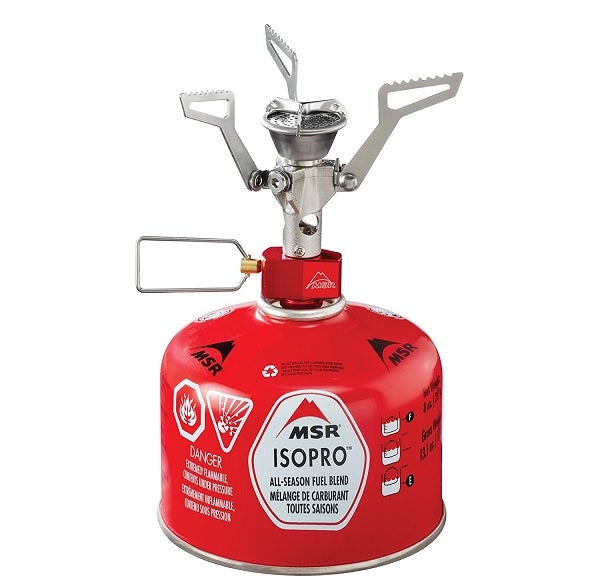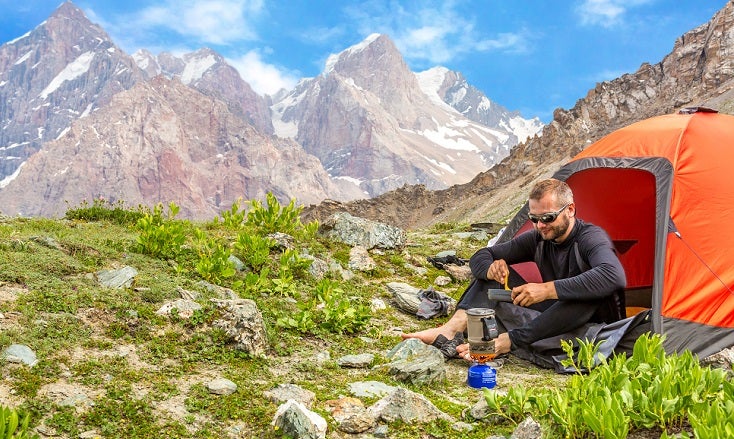
Our Editors independently research, test, and rate what we feel are the best products. We use affiliate links and may receive a small commission on purchases.
The best backpacking stoves are lightweight, reliable and easy to use. There quite a few stoves to consider with a variety of fuel choices.
We evaluated each stove based on size/weight, how versatile they were, fuel efficiency, ease of use and stability.
To help you make the right choice for a stove we have done the research so you don’t have to. Let’s get started!
Best Backpacking Stoves
For more of my backpacking gear recommendations, have a look through these popular Outside Pursuits guide links: Backpacking Tents, Backpacking Chairs, Backpacking Sleeping Bags.
Quick Answer: The 7 Best Rated Backpacking Stoves For 2021
Gas Burning Stoves
- MSR PocketRocket Backpacking Stove
- MSR WhisperLite Backpacking Stove
- MSR WindBurner Stove System
- Optimus Crux Weekend Cook System
- Hamans Camping Stove
Wood Burning Stoves
- Emberlit Fireant Titanium Wood Burning Backpacking Stove
- Solo Stove Compact Wood Burning Backpacking Stove
Our reviews of the top rated backpacking stoves with our guide and comparison table will help you choose the right stove for you.
Best Backpacking Gas Stoves
#1 MSR PocketRocket Backpacking Stove Review
- Fuel Source: isobutane-propane
- Weight: 2.6 oz
- Time to Boil: 3.5 Minutes
- Burn Time: 2.5 Hours
This little integrated canister fuel stove has been around for years. I remember buying my first canister stove and heavily considering this option. Fact is – it’s a great contender!
A feather light 3oz weight means you can enjoy the convenience and simplicity of canister stove use at a lightweight and compact point.
That weight will go up quickly when you consider that the stove doesn’t have a piezo ignitor or a wind screen and, therefore, you’ll need to carry your own.
Fast boil times of 3.5 min per liter are advertised but you’ll have a hard time realizing that number without a highly efficient pot and a nice windscreen.
MSR’s PocketRocket is a great choice if you’re looking for a dependable and economical choice in the canister fuel stove class which you won’t have to research or worry about.
They just work. Every time.
One major advantage of canister stoves is the ease of simmering and flame control. The MSR PocketRocket will be a pleasure to dial in with heat control.
Disadvantages include a narrow base which may be unstable. Speaking from experience, however, I can say that I never had an issue with stability on integrated canister stoves.
MSR is also manufactured by Cascade Designs which is known in the industry for exceptional customer service and quality.
If you’re buying the PocketRocket you’re buying a time-tested stove from a solid company with amazing service and products. One of the best hiking stoves available, you won’t go wrong with the PocketRocket.
#2 MSR WhisperLite Backpacking Stove Review
- Fuel Source: White gas
- Weight: 11 oz
- Time to Boil (1 Liter): Under 3.5 minutes
- Burn Time: 136 minutes
Here we have one of the most iconic and long standing pieces of equipment in the backpacking world. The Whisperlite stove has been around and in heavy use for decades.
A liquid fuel stove, the Whisperlite burns white gas fuel. With a total weight (pump, screens, and stove) of 14.5oz the stove isn’t the lightest option on the market by any means.
Learning to use the Whisperlite can be a little challenging at first and the open flame can be startling to newer backpackers.
Priming the stove requires a specific sequence of pressurization, fuel release, and lighting a small puddle of open white gas. It’s easy to forget the sequence and can be a little challenging at first.
Whisperlite stoves, if properly maintained, will last for decades of use and they’re nearly impossible to damage unless you’re careless.
MSR offers replacement parts for every piece of the stove and it’s easy to learn to disassemble, maintain, and repair every aspect of this stove.
In my opinion, the Whisperlite is the best backpacking canister stove on the market.
Once you learn about the Whisperlite you’ll see that it has a legendary place in the backpacking world based on ingenuity, reliability, and durability.
This is not a stove I would suggest for lightweight solo backpackers. It is, however, a great choice for group backpacking trips or camping trips as well as education groups.
While the not cheapest backpacking stove, it is a mid range priced option that is well worth the price.
This is a great stove to have in your backpack for its versatility and sheer dependability.
#3 MSR WindBurner Stove System
- Fuel Source: isobutane-propane
- Weight: 4 oz
- Time to Boil: Under 2 minutes
- Burn Time: 95 Minutes
MSR has the best lineup of anybody for backpacking stoves and the MSR Windburner is a relatively new edition to their lineup. The Windburner is an integrated canister stove and its main features are fuel efficiency and wind resistance.
Using the Windburner is about as simple as it gets. Simply add water, soup or any other liquid to the one-liter cooking cup and attach it to the burner. The rapid heating stove will have the contents boiling in 2 minutes or less.
The MSR’s “flux ring” technology gives the Windburner its heating efficiency. It securely attaches to the burner letting a minimum of heat escape and keeping the wind out with a built in windscreen.
One of the unique features of the Windburner’s cooking cup is the color change window that lets you know when the contents of the cooking pot are hot.
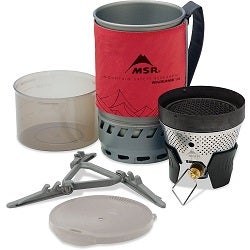
The cooking cup can be used to sip the contents directly without having to remove the lid.
There is a plastic bottom to the cup that comes off and can be used a cup for sipping or for a measuring cup.
MSR even includes a Cozy with a handle that fits around the up so you don’t burn your hand.
MSR included an important safety feature so that you can’t overheat and explode the cooking cup. The thermal trip mechanism shuts down the burner should it get too hot. This is a feature I really like.
One of its few downsides is the lack of a self-igniting piezo mechanism. You still need a lighter of marched to light it. This could be a pain when it’s really windy trying to get the fuel canister lit.
Since it is fairly tall it is susceptible to tipping over so you need to take care to place the stove on a flat, stable surface.
It includes a canister stand to give it more stability but it of course adds to the weight and is not absolutely necessary to carry along, saving a bit of weight.
Each fuel canister has enough heating power for 12 liters of liquid. One of the features I like best is the burner, and fuel canister all inside the cooking cup for very compact and efficient storage. All packed up it measures only 4 x 7 inches and weighs 15 ounces.
One of the latest innovations of the Windburner is the optional accessories available that significantly increases its versatility. The 1.8 liter cooking pot almost doubles its capacity.
The Windburner is by far the best solution when you want to boil water for freeze dried meals or soup. However now there is a skillet available for even more flexibility, you are not limited to liquids anymore.
With the accessories, the MSR Windburner can now handle all your cooking needs.
#4 Optimus Crux Weekend Cook System
- Fuel Source: isobutane-propane
- Weight: 8.1oz
- Time to Boil: 3 Minutes
- Burn Time: 90 Minutes
If you are looking for maximum flexibility with your cooking options then the Optimus Crux needs to be at the top of your list.
What I like about the Crux is that it comes with a frying pan and a pot for cooking/heating liquids.
Other backpacking stoves have these options of course, but none come with such an integrated package. The Crux is a low profile stove so it’s stable and can be used pretty much anywhere.
This model takes about 3 minutes to bring a liter of water to a boil.
It’s not as fast as the MSR Windburner because it doesn’t have the heating efficiency or wind resistance – but what it lacks in the time to boil, it makes up for in versatility.
The burner is incredibly light (230 grams) and you can very accurately control the heat with this burner. You are not just getting a stove but a cooking set with a pan and a pot.
It’s small, compact and convenient and comes with a mesh carry bag.
For a serious bargain price you are getting the best backpacking stove for the money.
#5 Hamans Camping Stove
- Fuel Source: Butane/Butane-propane mix
- Weight: 3.2 oz
- Time to Boil: N/A
- Burn Time: N/A
Weighing in at a mere 3.2 ounces, the Hamans Camping Stove is ultra-lightweight and exceptionally portable.
This model is made of aluminum alloy and heat-resistant stainless steel. Its strong valve connection allows for a strong flame even when adjusting from high to low settings.
An included carrying case further adds to the portability as it can simply be tossed in a bag without worry.
Because of its piezo ignition (push-button spark), it can even be lit without matches!
Always carry a Zippo lighter, however, because piezo ignitors are notorious for ceasing to work at the worst possible times.
This stove does everything it needs to do, for half the price of competing models. For this reason, its the best budget backpacking stove.
Best Wood Burning Backpacking Stoves
#6 Emberlit Fireant Titanium Backpacking Stove
- Fuel Source: Multi-fuel
- Weight: 2.8 oz
- Time to Boil: Varies on fuel
- Burn Time: Varies on fuel
Smokey The Bear will be proud of you for using the Fireant wood burning stove. When you want to use wood as your fuel source, then you need the Fireant.
This collapsible wood burning backpacking stove is made from PURE titanium. The same metal used in jet engines because it withstands heat and does not corrode, ever!
Once you put the slats together it forms a surprisingly sturdy stove that supports a fully loaded skillet or pot.
The design of the stove is such that it sucks in air from the bottom to burn the wood with minimal smoke.
It can boil a pot of water in short order and will never overheat. While it’s stable, you still have to take care to set it up on a flat surface.
It folds up to just 2 x 4.4 inches by a 1/8 of an inch thick and weighs about 4 ounces. You can take this stove absolutely anywhere!
The stove will burn practically anything that will fit in it. The huge advantage of the Fireant, and wood burning stoves in general is that you no longer need to carry around a fuel canister.
This saves not only money, but also weight! See my fire starter reviews of some good ones to bring with you.
It is also designed to use Esbit/Trangia alcohol burners. There is a slot you insert that is specially designed for these burners.
It’s not a bad idea to bring a few in case of rain and you are having trouble getting the wet wood lit.
I really like this backpacking stove, Emberlite offers a lifetime warranty, and its quality made in the USA. Although I can’t imagine you ever need the warranty. I would rate the Fireant as the best backpacking wood stove.
One thing I should mention is that the panels are laser cut and are fairly sharp. I cut myself on one of the panels, and had to sand the edges smooth.
#7 Solo Stove Wood Burning Backpacking Stove
- Fuel Source: Wood
- Weight: 9 oz
- Time to Boil: Under 8 minutes
- Burn Time: Varies
Backpacking Magazine didn’t recommend the Solo Stove for no reason. If you’re looking for a wood burning camping or backpacking stove the Solo Stove is a worthy contender.
The stove is extremely efficient. It has a patented design of a double wall that completely burns the wood in a much more completely than an open campfire.
The air is drawn in the bottom of the stove and as it heats up, air flows through the hollow wall and does a secondary burn at the top of the stove. The result is almost complete burning of the wood and hotter temperatures.
While its not going to boil water anywhere near as fast as the MSR Winburner it will get a liter of water boiling in about 8 minutes. You of course have the huge advantage of not toting around fuel canisters.
You can burn just about anything in it, twigs, pinecones and of course sticks. As soon as you get it lit, thicker sticks work best. The stove must be tended and you will need to keep adding fuel which is one downside, if you could call it that vs a canister stove.
It has an ash pan at the bottom so you don’t have to worry about ashes coming out the bottom but it gets very hot so be careful what you place it on. You can also use alcohol burners like the Trangia Spirit Burner.
The Solo Stove is made from 304 stainless steel which is about the best grade you can get and will not rust or corrode. Packed it measures about 4 inches high by 4 ¼ inches wide and weighs 9 ounces. Quite a bit more than the Fireant reviewed above but still compact and lightweight.
It is designed to work best with the Solo Stove Pot 900 and the stove fits inside of it saving space. The pot is also made of 304 stainless steel and the stove comes with a nylon mesh carry bag.
It’s hard to find anything to not like about this wood burning stove other than it doesn’t fold completely flat but its advantages more than make up for that and comes with a lifetime warranty.
Backpacking Stove Comparison Table
| Backpacking Stove | Fuel | Weight | Burn Time | Time to Boil | Rating | |
|---|---|---|---|---|---|---|
| MSR WhisperLite | White gas canisters | 11 oz. (305 g) | 136 minutes | Under 3.5 minutes | 4.4 / 5.0 | |
| MSR PocketRocket | Isobutane-propane fuel | 2.6 oz (73 g) | 60 minutes | Under 3.5 minutes | 4.6/ 5.0 | |
| MSR WindBurner Stove System | Isobutane-propane fuel canister | 15 oz (420 g) | 95 minutes | Under 4.5 minutes | 4.7 / 5.0 | |
| Optimus Crux Weekend Cook System | Isobutane-propane fuel | 8.1 oz (230 g) | 90 minutes | Under 3 minutes | 4.7 / 5.0 | |
| Hamans Camping Stove | Butane/butane-propane canisters | 3.2 oz (127 g) | N/A | N/A | 4.5 / 5.0 | |
| Emberlit Fireant Titanium Stove | Multi-Fuel | 2.8 oz (80 g) | Varies on fuel | Varies on fuel | 4.4 / 5.0 | |
| Solo Stove Wood Burning Stove | Wood or Alcohol | 9oz. (370 g) | Varies on fuel | Under 8 minutes | 4.7 / 5.0 |
How to Choose the Best Backpacking Stove
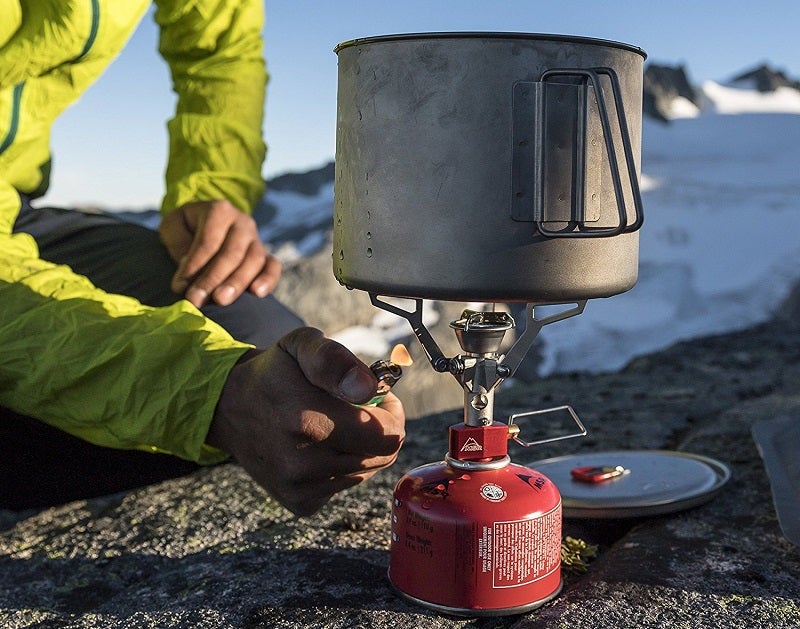
Standing toe to toe with all the choices and options of backpacking stoves can be more than a little daunting.
Depending on how light you pack, how long you’ll be gone, how many people are in your group, and what you’ll be cooking – among other things – will have great impact on your choices here.
Luckily for you, I’m going to help you walk through some of the choices so that you may make a more educated decision which will save you time, money, and fuel.
Not all backpacking stoves are the correct choice for each person and each trip so be aware that your choice of stove should, and will, change based on many factors.
Types of Backpacking Stoves
There are tons of backpacking stoves on the market and a dizzying array of styles. We’ll narrow them down to the most popular and talk about each in turn.
Liquid Fuel Stoves
Liquid fuel backpacking stoves use a bottle filled with raw fuel which is then pressurized and burned in the stove. One of the all-time most successful stoves, and a shining example of the liquid fuel stove, is the MSR Whisperlite.
Advantages of the liquid fuel stove include:
- Ability to burn many fuel types including diesel and gasoline (depending on the stove)
- Highly versatile choice particularly for group backpacking
- Can be tailored for use at extreme temperatures and elevations
Disadvantages include:
- Large and heavy stoves compared to others
- Liquid fuel may be prone to leaking
- Stoves are often relatively complex and require maintenance
Canister Stoves
Canister stoves are similar to liquid fuel but differ in that they consume pre-packaged cans of fuel which are already pressurized with a specific mixture of fuel. These stoves are usually more compact and very simple, often needing nothing more than the push of a button to operate. Canister stoves are not without fault, however.
Advantages of canister stoves:
- Simple design
- Convenient and easy to use
- Lighter, usually, than liquid fuel stoves
- Compact
Disadvantages include:
- Canisters cannot be refilled and must be carried out when empty
- Canisters may become ineffective in extreme elevation or cold
- Canister fuel can sometimes be difficult to purchase for resupply
It should be noted that canister stoves come in two variations: remote canister and integrated canister.
Wood / Solid Fuel Burning Backpacking Stoves
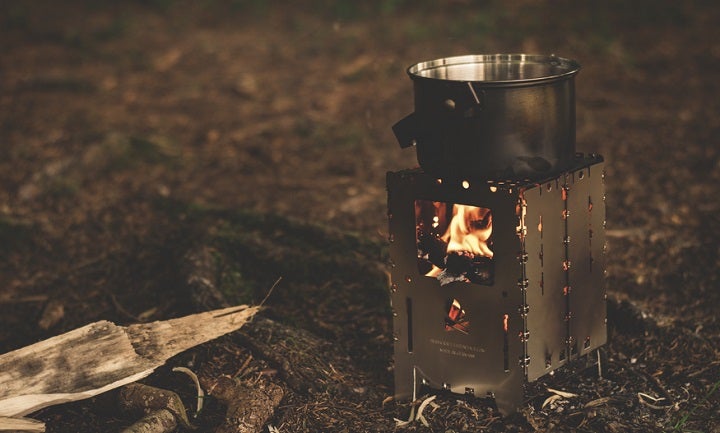
An old concept which has made a recent comeback, the wood and solid fuel burning stoves are uncommon but often the perfect solution for many niche backpackers.
There are actually several braches inside this category with the main differentiation being wood burning vs solid fuel (Esbit).
Wood Burning Stoves
Relatively inefficient compared to other options from the perspective of fuel consumed vs boiling time. It can often take a lot of upkeep to continue feeding your little wood burning titanium stove all the tiny twigs it needs to boil your water.
Wood burning titanium stoves can also be difficult to find and purchase as they are a very niche stove type. This means if you happen to crush, bend, or break your titanium stove it may be difficult or impossible to replace from the trail. You may have to order a new one and wait for the mail.
One huge disadvantage is that these stoves will not work in areas where there is no burnable fuel. Can’t find wood, or above the tree line?
You’re out of luck.
Solid Fuel Esbit Stove
Esbit stoves are currently my personal choice of stove. Esbit fuel tabs are very difficult to find and purchase while on the trail during resupply so be sure to mail yourself some or check with outfitters along the trail before leaving.
That being said, Esbit fuel tabs weigh very little and a huge quantity of them can be carried at a time for the efficient backpacker. Half a fuel tab will easily boil a cup of water for a reconstituted meal.
This is not the right system for the backpacker who must have two cups of warm coffee every morning and boil 4 cups of water for each meal.
Major advantages of esbit are extremely high fuel efficiency when paired with a good stove and extreme lightweight capability. They have an advantage over alcohol stoves because Esbit is a solid physical tablet of burnable fuel which cannot be spilled. This is convenient for preventing accidental conflagrations.
Alcohol Stoves
These little stoves are awesome inventions which have actually been around in other uses for many years. Alcohol stoves have many advantages but come with a few huge drawbacks.
Advantages of alcohol stoves:
- Can be made at home for less than $0.10
- Extremely lightweight
- Extremely simplistic
Disadvantages include:
- Can be extremely dangerous if not properly handled, raw open alcohol fuel may spill
- Very fragile stoves may be destroyed easily and may require some mechanical intuition
- Alcohol fuel is sometimes very difficult to find although many outfitters now carry it standard
How to Evaluate a Backpacking Stove
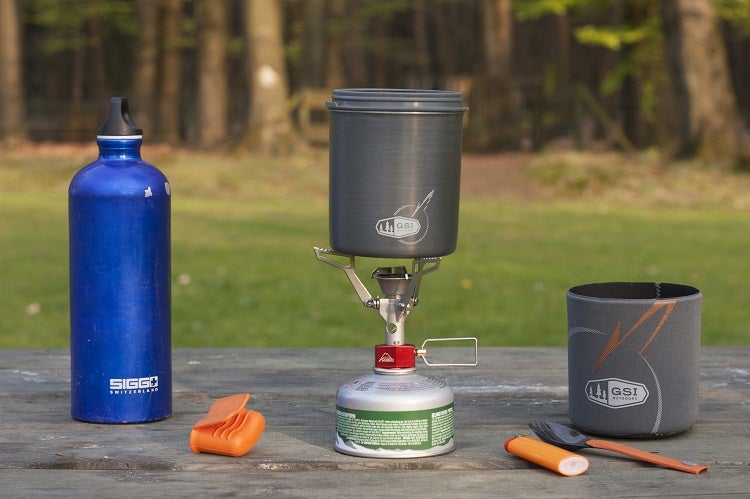
Versatility
A well-rounded stove will serve you well no matter what season or location you are entering. Keep in mind, however, that sometimes it’s better to have different stoves for different uses.
Fuel Efficiency
Some stoves are much more efficient than others. As a general rule liquid fuel stoves tend to be the least efficient.
Efficiency can be massively improved with things like wind screens, ground reflectors, and pot cozies.
Simple chemistry, however, dictates that some of the efficiency of the stoves be directly a result of stored chemical energy and combustion limitations.
Boil Time
Boiling time can be directly related to efficiency in many ways. Using a wind screen will increase efficiency and decrease boil time dramatically.
Some other factors impacting boil time include shape, size, and color of the pot in which water is being boiled.
Usually most stoves have a fine balance between boil time, efficiency, and fuel consumption so don’t just crank the stove wide-open and waste fuel. Do a little experimenting to find the best balance!
Weight
Weight can be a big factor and, if it’s your number one consideration, you’ll want to focus on alcohol, wood burning, or esbit stoves.
There’s plenty of information out there about the exact details but be prepared to do some serious research when deciding on your ideal stove for lightweight applications.
Liquid fuel stoves actually have a surprise advantage here in large group settings when people are planning to share stoves, fuel, and cooking equipment. If you do the math, you may find that a liquid fuel stove is actually lighter and more efficient for large group trips when properly planned.
Packed Size
It comes as no great surprise that the lighter stoves also take up less room. Alcohol, esbit, and wood stoves are by far the smallest.
Again, however, liquid fuel stoves may be a surprise competitor on group trips when you consider splitting up the gear between multiple people. It actually ends up taking up a pleasantly reasonable amount of space.
Canister stoves themselves are usually quite small but the annoyingly large fuel cans present an immediate downfall due to their bulk.
Conclusion
It’s almost impossible to go wrong with an MSR stove. If you’re looking for a great product from a great manufacturer, look no further.
Take your time and make sure to understand what type of stove is right for your uses before buying a new product!
How We Researched
To come up with the top backpacking stoves we researched a variety of sources for reviews such as REI, Bass Pro Shops, Cabelas and Backcountry along with our own personal experience.
We also consulted online magazines for product research and reviews to get as much unbiased information as we could. To help weed out fake reviews we used Fakespot.com to make sure we only looked at genuine reviews.
With so much quality gear available, we had to narrow it down based on what we felt were the best options for the price. The author, Casey Fiedler has been leading backpacking trips for over a decade in his native state of Michigan.
To help narrow down the selection he used his personal experience along with recommendations from fellow guides and outfitters.
After extensive research, we came up with our list to help you choose the right one for you.
Sources
I hope this guide was helpful for finding a good backpacking stove to fit your needs. If you want to comment or recommend a stove I didn’t include, please use my contact form to get in touch.
Have fun and be safe out there!

